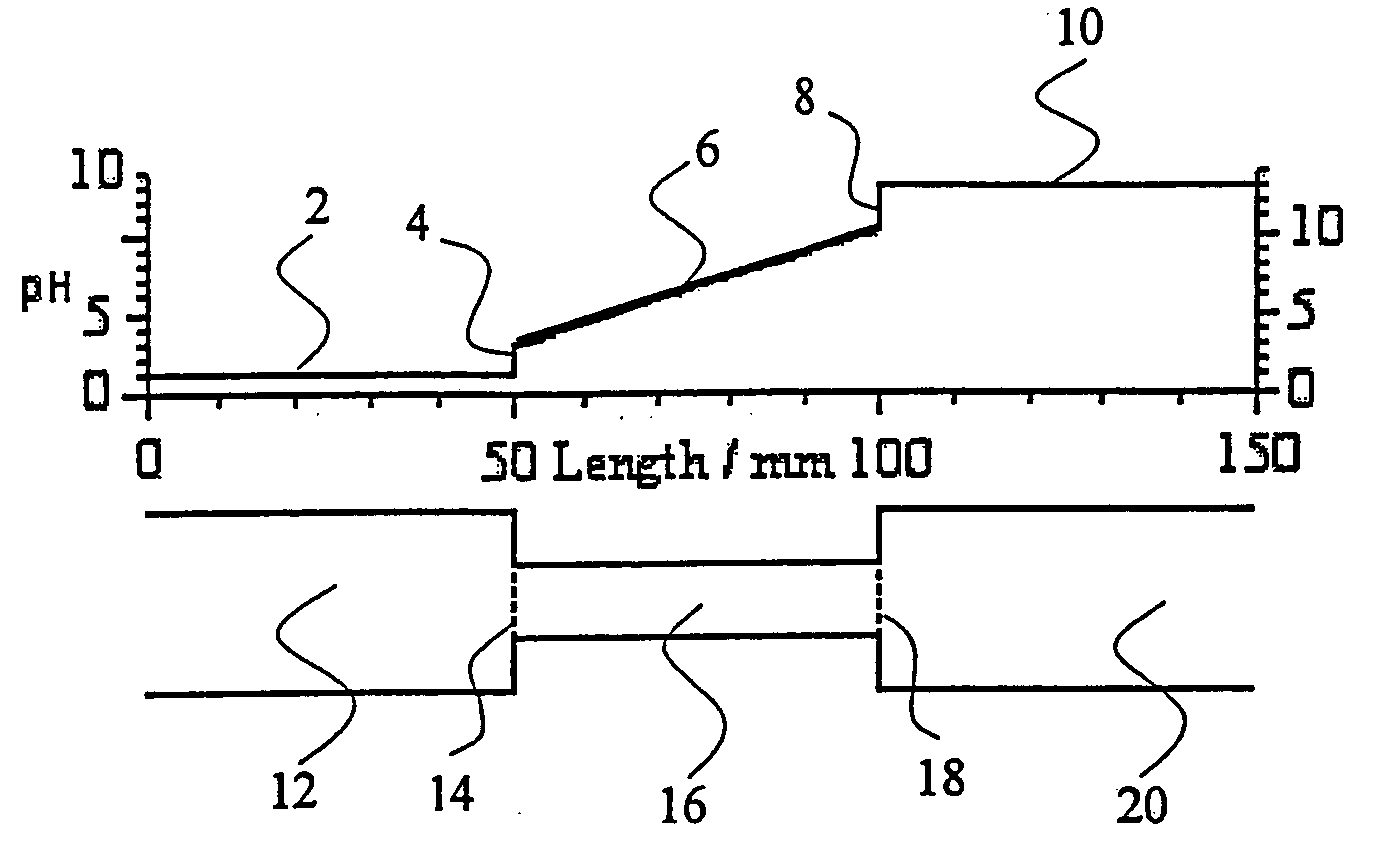Method and apparatus to improve the concentration detection sensitivity in isoelectric focusing systems
a technology of isoelectric focusing and concentration detection, applied in the field of isoelectric focusing, can solve the problems of not being able to achieve the effect of improving the concentration detection limit, and achieve the effect of simplifying the determination of the amoun
- Summary
- Abstract
- Description
- Claims
- Application Information
AI Technical Summary
Benefits of technology
Problems solved by technology
Method used
Image
Examples
example 1
[0042]FIG. 6 shows an iCIEF electropherogram of a chicken egg white sample taken without the addition of an auxiliary agent (top panel) compared to an iCIEF electropherogram of a chicken egg white sample taken with a cathodic auxiliary agent added (bottom panel) and demonstrates the effect of adding a cathodic auxiliary agent to the sample. The main components of chicken egg white are ovalbumin and ovotransferrin. The sample also contains five pI markers: the dansyl derivatives of three amino acids (DNS-Asp, DNS-Phe and DNS-Trp) and two aminophenols (terbutaline and tyramine). There are no auxiliary agents added to the sample. After isoelectric focusing the most acidic pl marker, DNS-Asp is at the anodic end of the viewing area of the separation capillary (at approximately 0 pixel), tyramine is at the cathodic end of the viewing area (at approximately 2050 pixel). The bottom panel shows that the addition of arginine as a cathodic auxiliary agent to the same chicken egg white sample ...
example 2
[0045]FIGS. 9-12 show the use of anodic and cathodic auxiliary agents to eliminate: compression of the pH gradient that was caused by the presence of salt in the sample. The sample is a mixture of pI markers DNS-Asp, DNS-Phe, DNS-Trp, terbutaline and tyramine, dissolved in 8% pH 3-10 Ampholine carrier ampholytes.
[0046]FIG. 9 shows the detector trace obtained for the pI marker sample in the iCIEF instrument, without any added auxiliary agent. On the anodic side, only the least acidic pI marker, DNS-GABA is visible at approximately 200 pixels. On the cathodic side, only the least basic pI marker, terbutaline is visible at approximately 1900 pixels. The other four pI markers focus outside the viewing area of the separation capillary.
[0047]FIG. 10 shows the detector trace obtained in the iCIEF instrument for the pI marker sample after iminodiacetic acid and arginine were added to it as anodic and cathodic auxiliary agents. Now all five pI markers are visible in the electropherogram, b...
example 3
[0051]FIG. 14, in the top panel, shows an electropherogram of a sample containing DNS-Trp, DNS-GABA, and labetalol as components of interest in a pH 3-10 Ampholine carrier ampholyte solution, N-(p-nitrobenzyl)-N-methylaminodiacetic acid as an anodic auxiliary agent, tyramine as a cathodic auxiliary agent, obtained in an iCIEF system equipped with a conventional separation capillary that does not contain auxiliary compartments. The concentration of the anodic auxiliary agent, N-(p-nitrobenzyl)-N-methylaminodiacetic acid, has been adjusted to cause it to invade about the first 100 pixels worth of the separation capillary, creating an easily visible absorbance front. The concentration of the cathodic auxiliary agent, tyramine, has been adjusted to cause it to invade about the last 100 pixels worth of the separation capillary, creating another easily visible absorbance front. The concentration of the ampholytic sample components of interest is so low, that only a small peak is visible f...
PUM
| Property | Measurement | Unit |
|---|---|---|
| Concentration | aaaaa | aaaaa |
| Solubility (mass) | aaaaa | aaaaa |
| Wavelength | aaaaa | aaaaa |
Abstract
Description
Claims
Application Information
 Login to View More
Login to View More - R&D
- Intellectual Property
- Life Sciences
- Materials
- Tech Scout
- Unparalleled Data Quality
- Higher Quality Content
- 60% Fewer Hallucinations
Browse by: Latest US Patents, China's latest patents, Technical Efficacy Thesaurus, Application Domain, Technology Topic, Popular Technical Reports.
© 2025 PatSnap. All rights reserved.Legal|Privacy policy|Modern Slavery Act Transparency Statement|Sitemap|About US| Contact US: help@patsnap.com



